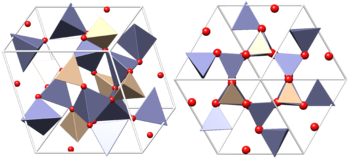Willemite
| Willemite | |
|---|---|
 Willemite fromNamibia | |
| General | |
| Category | Silicate mineral |
| Formula (repeating unit) | Zn2SiO4 |
| IMA symbol | Wlm[1] |
| Strunz classification | 9.AA.05 (10 ed) 8/A.01-20 (8 ed) |
| Dana classification | 51.1.1.2 |
| Crystal system | Trigonal |
| Crystal class | Rhombohedral(3) (sameH-M symbol) |
| Space group | R3 |
| Identification | |
| Color | Colorless to white, gray, black, flesh-red, burgundy-red, pink, brown, dark brown, mahogany-brown, honey-yellow, yellow, apple-green, blue, pastel green, light blue, azure-blue |
| Crystal habit | Fibrous,botryoidalto massive |
| Cleavage | {0001}, {1120} – imperfect |
| Fracture | Irregular to conchoidal |
| Mohs scalehardness | 5.5 |
| Luster | Vitreous to resinous |
| Diaphaneity | Transparent to opaque |
| Specific gravity | 3.9 – 4.2 |
| Optical properties | Uniaxial (+) |
| Refractive index | nω = 1.691 – 1.694 nε = 1.719 – 1.725 |
| Birefringence | δ = 0.028 |
| Other characteristics | Stronglyfluorescent;may bephosphorescent |
| References | [2][3][4] |
| Major varieties | |
| troostite | zinc is partly replaced bymanganese |
Willemiteis a zincsilicate mineral(Zn2SiO4) and a minor ore of zinc. It is highlyfluorescent(green) under shortwaveultravioletlight. It occurs in a variety of colors in daylight, in fibrous masses and apple-green gemmy masses.Troostiteis a variant in which part of the zinc is partly replaced bymanganese,it occurs in solid brown masses.
It was discovered in 1829 in the BelgianVieille-Montagnemine.Armand Lévywas shown samples by a student at the university where he was teaching. Lévy named it afterWilliam I of the Netherlands[5] (it is occasionally spelledvillemite).[6][7][8] The troostite variety is named after Dutch-American mineralogistGerard Troost.[9]
Occurrence[edit]

Willemite is usually formed as an alteration of previously existingsphaleriteore bodies, and is usually associated withlimestone.It is also found in marble and may be the result of a metamorphism of earlierhemimorphiteorsmithsonite.[10]Crystals have the form of hexagonal prisms terminated by rhombohedral planes: there are distinct cleavages parallel to the prism-faces and to the base. Granular and cleavage masses are of more common occurrence.[11]It occurs in many places, but is best known from Arizona and the zinc, iron, manganese deposits atFranklinandSterling Hill MinesinNew Jersey.It often occurs with redzincite(zinc oxide) andfranklinite(Fe,Mn,Zn)(Fe,Mn)2O4(an iron rich zinc mineral occurring in sharp blackisometricoctahedral crystals and masses). Franklinite and zincite are not fluorescent.
Uses[edit]

Artificial willemite was used as the basis of first-generationfluorescent tubephosphors.Doped with manganese-II, it fluoresces with a broad white emission band. Some versions had some of the zinc replaced withberyllium.In the 1940s it was largely replaced by the second-generation halophosphors based on thefluorapatitestructure. These, in turn have been replaced by the third-generation TriPhosphors.[12][13]

See also[edit]
References[edit]
- ^Warr, L.N. (2021)."IMA–CNMNC approved mineral symbols".Mineralogical Magazine.85(3): 291–320.Bibcode:2021MinM...85..291W.doi:10.1180/mgm.2021.43.S2CID235729616.
- ^Anthony, John W.; Bideaux, Richard A.; Bladh, Kenneth W.; Nichols, Monte C. (2005)."Willemite"(PDF).Handbook of Mineralogy.Mineral Data Publishing.Retrieved23 July2022.
- ^Willemite,Mindat.org,retrieved23 July2022
- ^Barthelmy, David (2014)."Willemite Mineral Data".Webmineral.Retrieved23 July2022.
- ^Denayer, Julien; et al. (2017)."Les sciences géologiques à l'Université de Liège: deux siècles d'évolution Partie 1: de la fondation à la Première Guerre Mondiale".Bulletin de la Société Royale des Sciences de Liège(in French).86.doi:10.25518/0037-9565.7303.ISSN0037-9565.S2CID134239255.
En 1829, [Armand Lévy] décrivit la willémite [...], nouvelle espèce minérale découverte à la Vieille-Montagne à Moresnet, et la dédia à Guillaume (Willem) 1erdes Pays-Bas (Lévy, 1830; Lacroix, 1919; Buttgenbach, 1947a). « Ce minéral, très-abondant à Moresnet, avait échappé à l'attention des minéralogistes qui avaient visité cette localité, lorsqu'un élève de l'université de Liége en apporta plusieurs morceaux qui me parurent appartenir à une espèce différente de celles que je connaissais; en conséquence je me rendis sur les lieux, et, après avoir mûrement examiné les nombreux échantillons que j'y rencontrai, je fus convaincu que ma conjecture était fondée » (Lévy, 1843).
(Translation: "In 1829, [Lévy] described willemite, a new mineral discovered atMoresnet'sVieille-Montagneand dedicated to William I of the Netherlands. "The mineral—quite abundant in Moresnet—went unnoticed by mineralogists who had visited this location. A student of theUniversity of Liègebrought me several pieces that I was unfamiliar with, so I went to these places. After carefully examining the many samples that I came across, I was convinced that my supposition was founded. ") - ^See:
- Levy, A. (1830)."Lüttich, 14. September 1829".Jahrbuch für Mineralogie, Geognosie, Geologie und Petrefaktenkunde(in German).1:71.From p. 71:"Bei einer Exkursion, welche ich neulich gemacht, glaube ich ein neues Mineral entdeckt zu haben; es soll Willemite heissen, nach S.M. dem König der Niederlande."(During an excursion which I made recently, I believe that I discovered a new mineral; it shall be called "Willemite", after His Majesty the King of the Netherlands.)
- Chester, Albert Huntington (1896).A Dictionary of the Names of Minerals Including Their History and Etymology.New York City, New York, USA: John Wiley & Sons. p.288.
- ^Wurtz, Charles Adolphe (1878).Dictionnaire de chimie pure et appliquée.Hachette. p. 722.
Syn.Wihlemite,williamsite,troostite. [...] dans les amas decalaminede la Vieille-Montagne
- ^Bulletin de Minéralogie(in French). Masson. 1919. p. 127.
Ainsi s'explique qu'en 1829 il ait dédié au roi des Pays-Bas, Wilhem I, lavillemite,qu'il venait de découvrir à la Vieille-Montagne.
( "[...] in 1829 he dedicated to the king of the Netherlands, William I, thevillemite,which he had just discovered at Vieille-Montagne. ") - ^"troostite".Merriam-Webster Dictionary.
- ^Klein, Cornelis (2007).The Manual of Mineral Science,p.484. John Wiley and Sons, Inc., Hoboken.ISBN9780471721574.
- ^One or more of the preceding sentences incorporates text from a publication now in thepublic domain:Spencer, Leonard James(1911). "Willemite".InChisholm, Hugh(ed.).Encyclopædia Britannica.Vol. 28 (11th ed.). Cambridge University Press. p. 658.
- ^Thayer, R. N."The Fluorescent Lamp: Early U. S. Development".
- ^Kane, Raymond; Sell, Heinz (2001)."A Review of Early Inorganic Phosphors".Revolution in lamps: a chronicle of 50 years of progress.p. 98.ISBN978-0-88173-378-5.
External links[edit]
 Media related toWillemiteat Wikimedia Commons
Media related toWillemiteat Wikimedia Commons
